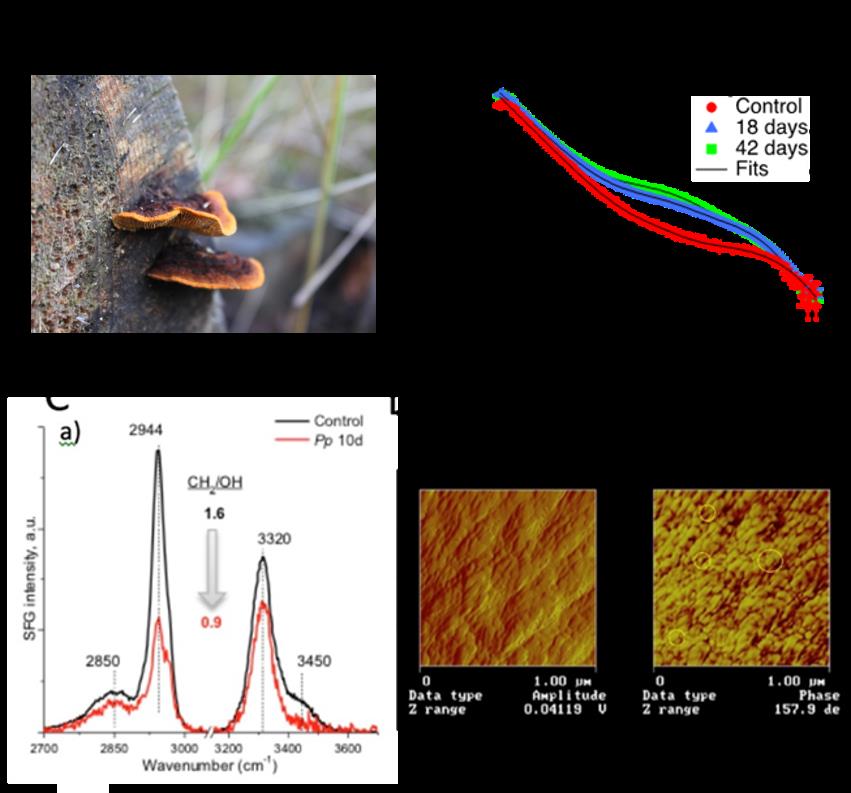Brown Rot Fungi Reveal a New Approach for Biomass Conversion to Fuels and Chemicals
07/11/2017

(A) Brown rot fungi mushrooms, (B) SANS profiles, (C) SFG spectra of brown rot fungi–mediated cellulose deconstruction, and (D) AFM images of repolymerized lignin in brown rot cell walls. [(A) Wikimedia Commons, Zinnmann; (B) Authors; (C) and (D) From Goodell, B., et al. “Modification of the Nanostructure of Lignocellulose Cell walls via a Non-Enzymatic Lignocellulose Deconstruction System in Brown Rot Wood-Decay Fungi.” Biotechnol. Biofuels 10, 179 (2017). [DOI 10.1186/s13068-017-0865-2]. Reused under a Creative Commons license (CC BY 4.0, https://creativecommons.org/licenses/by/4.0/).]
A multimodal approach used in this study examined wood decay by the brown rot fungi, Gloeophyllum trabeum or Rhodonia placenta, that degrade wood using a chelator-mediated Fenton (CMF) reaction. Small-angle neutron scattering (SANS) showed changes in microfibril bundling and lignin structure during biomass breakdown. Complementary approaches, sum frequency generation (SFG) spectroscopy, X-ray diffraction, atomic force microscopy (AFM), and transmission electron microscopy (TEM) also contributed information on nanoscale structural changes in wood over time. Woods studied were southern yellow pine (Pinus spp.) and birch (Betula verrucosa Ehr.). The data support a degradation mechanism in which sugars released by non-enzymatic action diffuse from the cell wall, facilitated by increasing the porosity of the cell walls. This is a paradigm shift in understanding the mechanism of brown rot fungal degradation.
Funding Acknowledgements
Dr. Zhu support: Chinese Forestry Industry Research Special Funds for Public Welfare Projects (#201204702-B2). Eastwood support: UK Natural Environment Research Council, award #NE/K011588/1. Daniel support: Formas Grant 2015-469. Support from ORNL-Proposal IPTS-12345/CG-3. Sum frequency generation (SFG) spectroscopy, x-ray diffraction (XRD), and infrared (IR) studies support: Center for Lignocellulose Structure and Formation, an Energy Frontier Research Center, funded by the Office of Basic Energy Sciences (OBES), U.S. Department of Energy (DOE) Office of Science, under Award Number DE-SC0001090. Pingali and O’Neill support: Biofuels SFA funded by the DOE Genomic Science Program, Office of Biological and Environmental Research (OBER), under Contract FWP ERKP752. Bio-SANS support: Center for Structural Molecular Biology, supported by DOE OBER under Contract FWP ERKP291. Neutron scattering facilities at Oak Ridge National Laboratory (ORNL) support: Scientific User Facilities Division, DOE OBES. Research also supported by U.S. Department of Agriculture’s (USDA) National Institute of Food and Agriculture (NIFA) and University of Massachusetts Amherst’s Center for Agriculture, Food and the Environment and the Microbiology Department: project # MAS00511.
Instruments and Facilities
Small angle neutron scattering (SANS) – Bio-SANS at High Flux Isotope Reactor (HFIR) at Oak Ridge National Laboratory (ORNL). Sum frequency generation (SFG) spectroscopy, broadband SFG system. Chelator-mediated Fenton treatments (CMF) and cellulase treatment. X-ray diffraction analysis (XRD) – PANalytical Empyrean diffractometer, The Netherlands, equipped with a Cu X-ray source. Attenuated total reflectance Fourier transform infrared analysis (ATR-FTIR): Nicolet 8700 FTIR Spectrometer (Thermo Scientific) equipped with a smart iTR diamond ATR unit, a KBr beam splitter, and a deuterated triglycine sulfate (DTGS) detector. Atomic force microscopy (AFM) of brown-rotted wood surfaces. Nanoscope IIIa AFM-Digital Instruments, Santa Barbara, California with three 5 µm scans. Transmission electron microscopy (TEM) – Philips CM12 TEM instrument (Philips, Eindhoven, The Netherlands); images recorded on Kodak 4489 negative film and the films subsequently scanned using an Epson Perfection Pro 750 film scanner.
Related Links
References
Goodell, B., et al. “Modification of the Nanostructure of Lignocellulose Cell Walls via a Non-Enzymatic Lignocellulose Deconstruction System in Brown Rot Wood-Decay Fungi.” Biotechnol. Biofuels 10(1), 179 (2017). [DOI:10.1186/s13068-017-0865-2]
